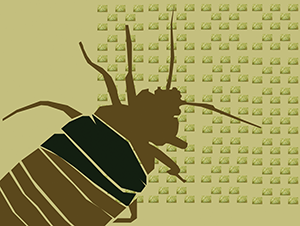New Research Entangles Bed Bugs
 |
|
Bed bug. Illustration: Chris Gonzales |
Scientists are learning new secrets of bed bug biology that could help us lure and trap them.
As bed bugs have become more prevalent, so have studies to find out what attracts them. Research has shown that a type of dry-ice lure is effective, but the lack of availability of dry ice is a problem. In the laboratory of Changlu Wang, an entomologist at Rutgers University, a group has investigated other potential substances and found yeast and sugar to be equally attractive. Their widespread availability gives them an advantage for homemade traps. Unfortunately, given the choice, bed bugs will still prefer live humans over this lure.
In addition to luring bed bugs, Wang and his team are also studying bed bug vision and mechanoreception. Subtle differences in texture and color can change the efficacy of bed bug monitors. They find bed bugs prefer red and black colored harborages. Bed bugs also have a preference for rough surfaces, like paper surgical tape, but will avoid fuzzy textures, like felt, which are too coarse for the bed bugs to move through easily.
Wang’s team incorporated their findings about bed bug biology into an IPM approach. They have documented the success of the IPM program they developed for bed bugs in an apartment complex. Their method involved monitoring and then biweekly chemical and non-chemical treatments based on bed bug counts. They reduced bed bug numbers by 98 percent and brought the number of infested apartments down from 15 percent to 2 percent after 12 months.
Wang and his team are going full circle in understanding pest biology, testing their findings, and measuring results. That’s called practicing IPM.
— by CHRIS GONZALES
The Northeastern IPM Center promotes integrated pest management for reducing risks to human health and the environment. If republishing our news, please acknowledge the source (“From Northeast IPM Insights”) along with a link to our website.
